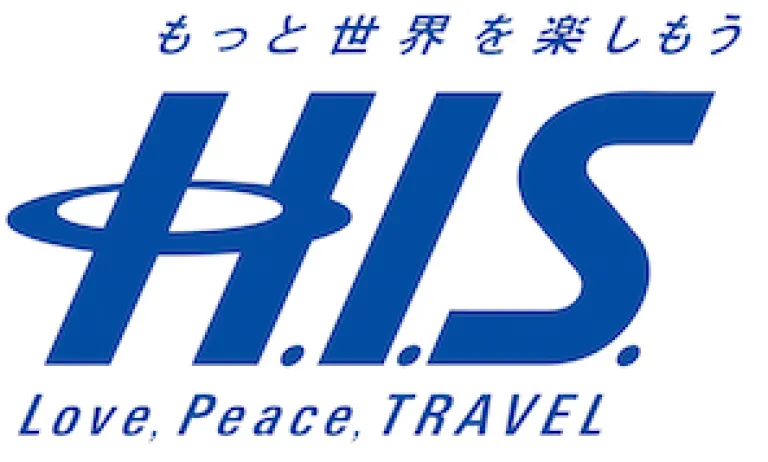10 days in Southern Vietnam with less than ₱15k budget. Learn how this Filipina did it!
The Ultimate Food & Sakura Itinerary That Maximises the JR East Pass (Tohoku)

As Japan transitions out of freezing temperatures and long nights, the country welcomes signs of spring with much joy and enthusiasm. This is all the more so for sakura blooms, as a wave of pink sweeps up the country from Okinawa to Hokkaido.
Tohoku is gifted with breathtaking natural beauty, making it a picturesque region all year round. Located in northern Honshu just below Hokkaido, it experiences cooler temperatures compared to other regions, and its scenery transforms significantly across the four seasons. Sakura blooms in Tohoku consequently appear from early April to early May – later than those in popular areas such as Tokyo and Osaka – allowing one to view them after peak travel periods.
The Tohoku region is easily accessible from Tokyo, a mere 90-minute ride on the bullet train takes you from Tokyo to Sendai, the largest city in the Tohoku region. Knowing where to go and what to do is half the battle (of getting the best viewing spots) won, and knowing how to get there is the other half. That’s exactly what this article is about: helping you to plan the schedule and journeys of your trip to make the most of it.
|
The JR East Pass (Tohoku Area) is the best way to get around the region easily and with the most bang for your buck. It’s priced only as much as two shinkansen rides between Tokyo and Sendai – incredible value for money as you’ll be getting unlimited rides all over Tohoku! Allowing for 5 days of usage within a 14-day period, you can take your time to explore and rest in each destination, only using the Pass on days that you’re making the longer trips to other cities. |
For details about the sakura spots, they are covered in greater detail in our previous article, 6 Insta-worthy Sakura Spots in Japan: Vibrant Blossoms, Snow-capped Mountains + More!
Here’s our itinerary for you to maximise the five days of pass usage, catching the best blooms and eats across Tohoku with the help of the JR East Pass!
Day 1 of Pass Usage: Tokyo → Hanamiyama Park → Miharu Takizakura → Sendai
Hanamiyama Park
By train: Tokyo Station → Fukushima Station
Viewing period: early – late April

Lose yourself in bursts of colour as you explore the hillside Hanamiyama Park. Ten varieties of sakura fill the park in splashes of pink, white and yellow – with the faraway Azuma mountains as a backdrop. Once a private garden maintained by the owners as a sight to return home to, the park was opened to the public in 1959 so that its beauty could be enjoyed by all.
Address: Watari, Fukushima City, Fukushima Prefecture
Nearest station: JR Fukushima Station
Getting there: From JR Fukushima Station, take a 15-minute bus ride (only available during the sakura season) and a 10-minute walk from the bus stop
Admission: Free!
Miharu Takizakura
By train: Fukushima Station → transfer at Koriyama Station → Miharu Station
Viewing period: mid – late April

Touted as the single most beautiful sakura tree in all of Japan, the majestic Miharu Takizakura welcomes streams of visitors from all over the country and beyond under its sweeping canopy. The blooms on this thousand-year-old takizakura (water sakura) sweep down from a height of four storeys and is illuminated at night with an otherworldly glow.
Address: Sakurakubo, Taki, Miharu Town, Tamura County, Fukushima Prefecture
Nearest station: JR Miharu Station
Getting there: a 20-minute bus ride from JR Miharu Station to Miharu Takizakura is available during sakura season.
Admission: ¥300
Spend the night in Sendai City, or extend your stay!
By train: Miharu Station → transfer at Koriyama Station → Sendai Station
After having your fill of sakura viewing for the day, take the train to Sendai Station for a night’s rest in the city, or lengthen your time here and check out:
Zuihoden Mausoleum
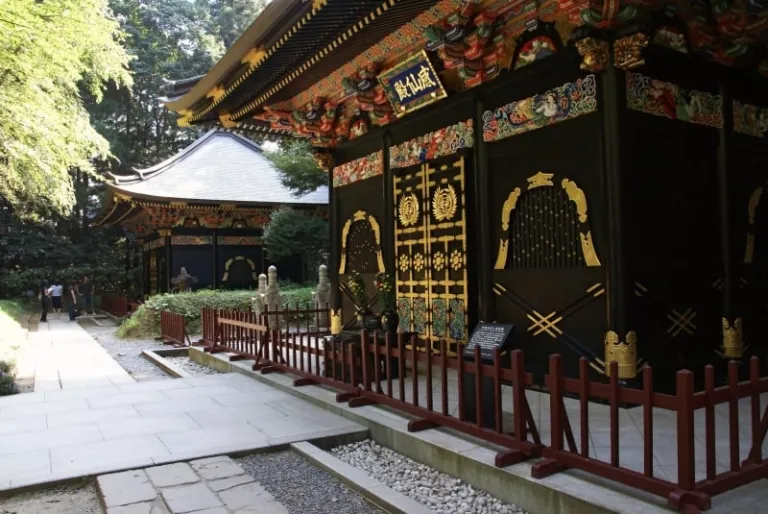
Marvel at rare Momoyama architecture at Zuihoden Mausoleum, where the three rulers of Sendai from the Date clan are laid to rest. Learn more about the Date family in the mausoleum’s main building – specimens of bone and hair are preserved here – or take in the serenity among the towering cedar trees that surround the area.
Address: 23-2 Otamayashita, Aoba Ward, Sendai, Miyagi Prefecture 980-0814, Japan
Getting there: 15 min by bus from Sendai Station
Admission: ¥550
Yamadera
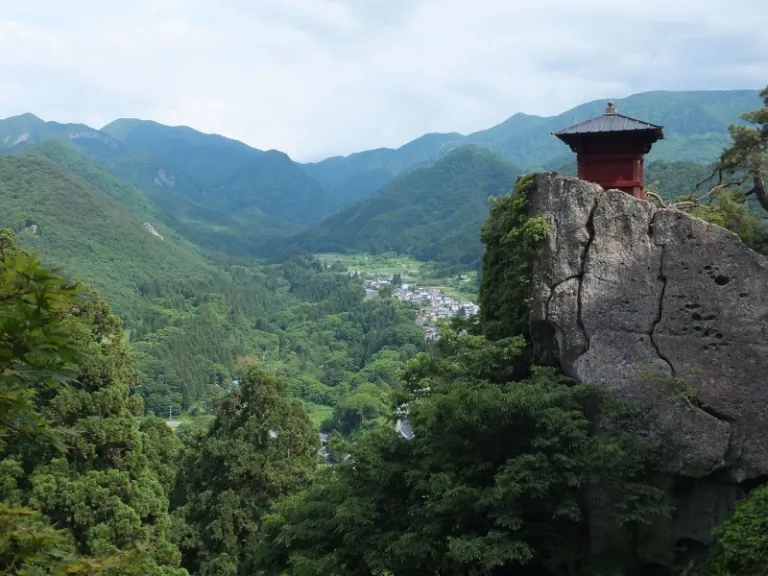
Located high in the mountains between Yamagata and Sendai, this historic temple takes 1,015 steps to reach – the journey up is an experience in itself. Join the crowd as you trek up through the Japanese countryside and explore Yamadera’s sprawling complex, taking in refreshing scenes of nature along the way.
Address: 4456-1 Yamadera, Yamagata, Yamagata Prefecture 999-3301, Japan
Getting there: Walk from JR Yamadera Station, which is ~50min by train from Sendai on the local line (¥840 for a one-way ticket)
Admission: ¥200–400 depending on each attraction
Matsushima
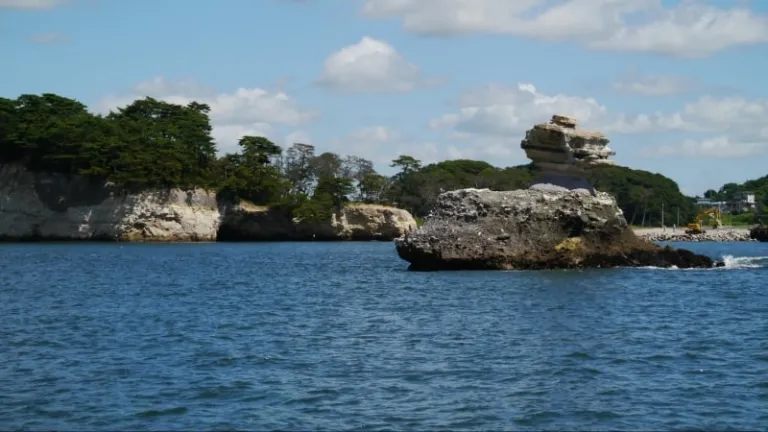
Wander along Matsushima, one of Japan’s top three scenic places, where you can take in sights of its 260 pine-covered islets. Stroll through nature and visit Zuiganji or take in the ocean breeze on a sightseeing cruise.
Address: Matsushima cho Miyagi-gun, Miyagi Prefecture
Getting there: Walk from JR Matsushima-Kaigan Station, which is ~40min by train from Sendai on the local line (¥410 for a one-way ticket)
Admission: Free to Godaido, ¥200 to cross the bridge to Fukuura Island, ¥1,500 for a 50-min sightseeing boat ride
Shopping at Mitsui Outlet Park Sendai Port and downtown Sendai
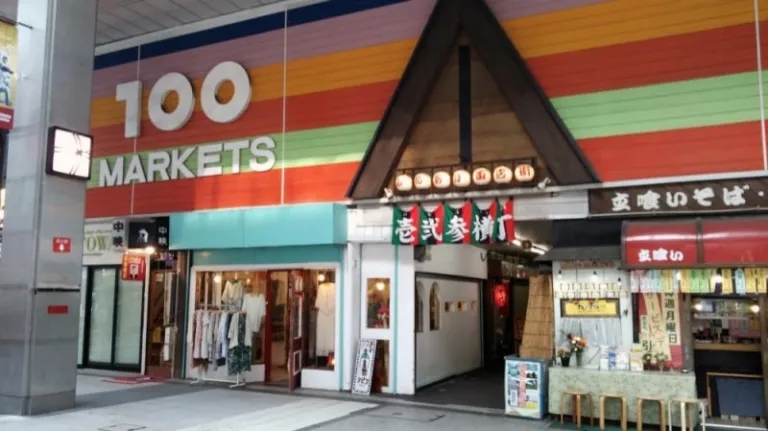
If you’re up for some shopping, explore the various brand outlets at Mitsui Outlet Park Sendai, the largest outlet mall in the Tohoku region, or hunt for good buys at downtown Sendai in places such as Ichibancho Arcade and Asaichi Market.
Hop onto the Ferris wheel at Mitsui Outlet Park Sendai, where you’ll be able to catch sight of the magnificent Mount Zao in the distance. You can also check out the observation deck of the AER Building in downtown Sendai, where you can take in aerial views of Sendai City.
Address: 3 Chome-7-2 Nakano, Miyagino Ward, Sendai, Miyagi Prefecture 983-0013, Japan
Getting there: Walk from JR Nakano-sakae Station, which is a 20-min train ride from Sendai by local train (¥200 for a one-way ticket)
Admission: Free!
Food to try
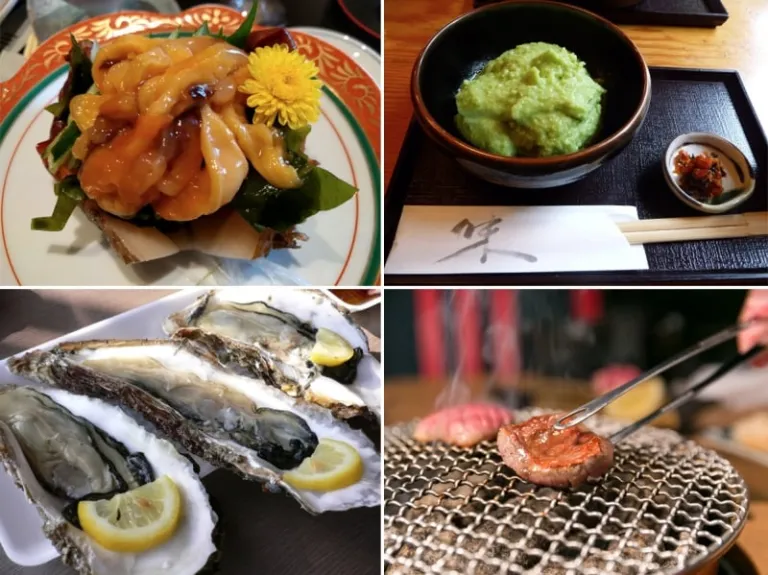
Oysters are a must-try here in one of Japan’s major oyster-producing cities, and if you’re feeling adventurous, seek out the Hoya (Sea Pineapple) that’s bursting with flavours of the sea. Gyutan (Grilled Ox Tongue) is a local speciality beef lovers should try out, while Zunda Mochi, made of mochi and mashed edamame, is a healthy snack that’s light in taste yet incredibly filling.
Day 2 of Pass Usage: Sendai → Toreiyu Tsubasa (Footbath Train) → Funaoka Joshi Park & Shirakawa Riverside → Morioka
Toreiyu Tsubasa (Fukushima Station → Yamagata Station)
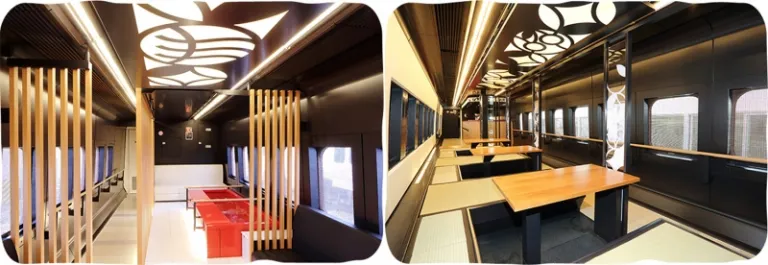
From Sendai Station, take the train to Fukushima Station, where you can catch the Toreiyu Tsubasa Joyful Train. En route to Yamagata, give your feet a treat and hop into a warm ashiyu (foot bath) on the Toreiyu Tsubasa, a hot spring-themed shinkansen paying homage to Yamagata’s many hot springs.
Lined with tatami mats and housing a bar serving drinks from the region, you can recharge your senses in an environment akin to a hot spring town as you gaze out at the passing scenery outside.
Admission: Free with JR East Pass; reservation required. Tickets for the foot bath can be purchased on board if there are vacancies.
Funaoka Joshi Park & Hitome Senbonzakura at the Shirakawa Riverside
By train: Yamagata Station → transfer at Sendai Station → Funaoka Station
Viewing period: early – mid April
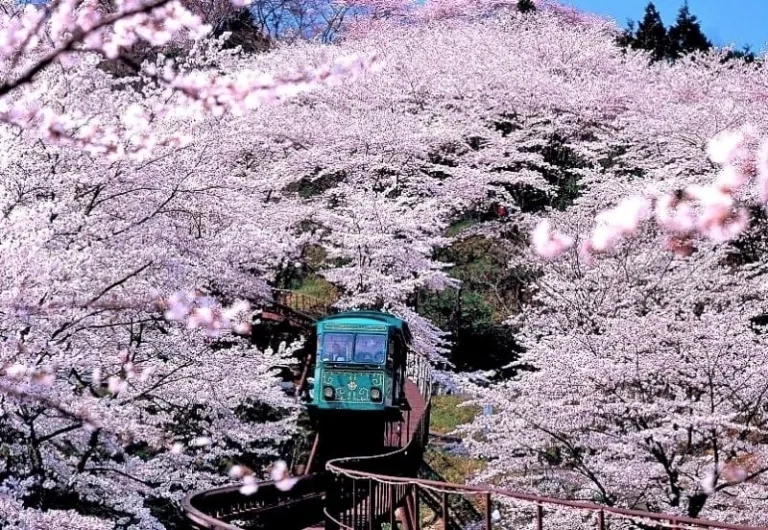
Ride through a 300m tunnel of delightful pink at Funaoka Joshi Park, the only site in Miyagi to be among Japan’s Top 100 Sakura Viewing Spots. The charming, cosy monorail will take you through the blossoms before you arrive at the 24m-tall Funaoka Heiwa Kannon statue.
There, you’ll be greeted by panoramic views of snowy Mount Zao and Hitome Senbonzakura along the nearby Shirakawa Riverside, an 8km tunnel of 1,200 sakura trees which you can get to via a connecting bridge.
The cherry blossom festivals in Shibata and Ogawara also happen in early to mid April, when the trees are in full bloom.
Funaoka Joshi Park
Address: Funaokajoshi Koen, Funaoka, Shibata, Shibata-gun, Miyagi Prefecture
Nearest station: JR Funaoka Station
Getting there: 15-minute walk from JR Funaoka Station
Admission: Free!
Hitome Senbonzakura
Address: Shiroishi Riverside, Shibata, Ogawara Town, Miyagi Prefecture
Nearest station: JR Ogawara Station and JR Funaoka Station
Getting there: 3-minute walk from JR Ogawara Station or 15-minute walk from JR Funaoka Station
Admission: Free!
Spend the night in Morioka City, or extend your stay!
By train: Funaoka Station → Sendai Station (luggage pick-up) → Morioka Station
After enjoying the Toreiyu Tsubasa and sakura viewing experiences, head back to Sendai to collect your luggage before continuing on to Morioka.
Hiraizumi
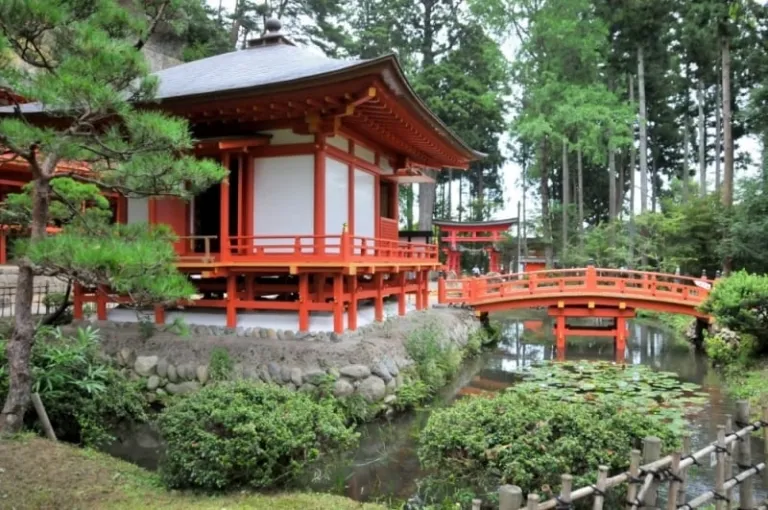
Named as Tohoku’s first UNESCO World Heritage Site in 2011, Hiraizumi is home to several gardens, temples and historical buildings.
Stroll through Motsuji Temple’s sprawling garden, one of the two remaining Pure Land gardens in Japan built to resemble the Buddhist paradise. Marvel at the intricate gold-leaf designs of Konjikido, a 12th-century structure that can be found at Chusonji Temple.
Address: 45-2 Hiraizumi Shirayama, Hiraizumi-chō, Nishi-Iwai-gun, Iwate-ken 029-4192
Getting there: 5 min by bus from JR Hiraizumi Station, which is ~80min from Morioka Station.
Admission: ¥300–800 depending on each attraction
Jodogahama Beach
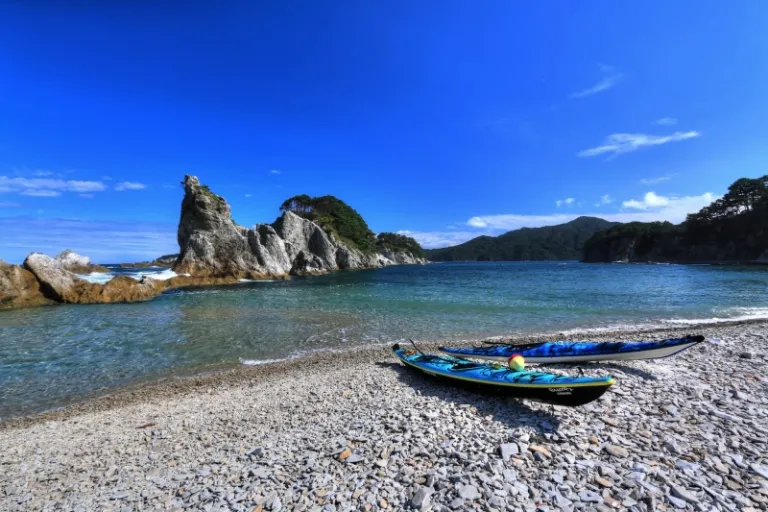
Be mesmerised by spectacular sunsets, clear waters and white pebble shores at one of Japan’s 100 Best Beaches, Jodogahama Beach (Pure Land Beach) – its beauty is comparable to that of the Pure Land itself. Explore the area through walking trails, and even take cruise rides to the nearby caves!
Address: Hitachihamacho, Miyako 027-0001, Iwate Prefecture
Getting there: 15 min by bus from JR Miyako Station, which is about a 2-hour train ride away from JR Morioka Station.
Admission: ¥1,400–1,500 yen for boat cruises
Food to try

Morioka has “Three Great Noodles” that you must indulge in during your trip.
Wanko Soba is an eat-till-you-drop experience for those who love their soba. Waiters are on standby to refill your bowls while you try to slurp down as many servings of soba as you can. Try to hit 80 bowls for women and 100 bowls for men – the challenge ends once you stop!
Reimen (cold noodles) combines the culinary cultures of Korea and Japan to create a refreshing yet zesty experience. Last but not least, dig into a plate of Jajamen, noodles served with miso paste, minced meat and chopped vegetables. Don’t forget to taste the special chi tan tan (egg soup)!
Day 3 of Pass Usage: Morioka → Kitakami Tenshochi → Geibikei → POKÉMON with YOU Train → Akita
Kitakami Tenshochi
By train: Morioka Station → Kitakami Station
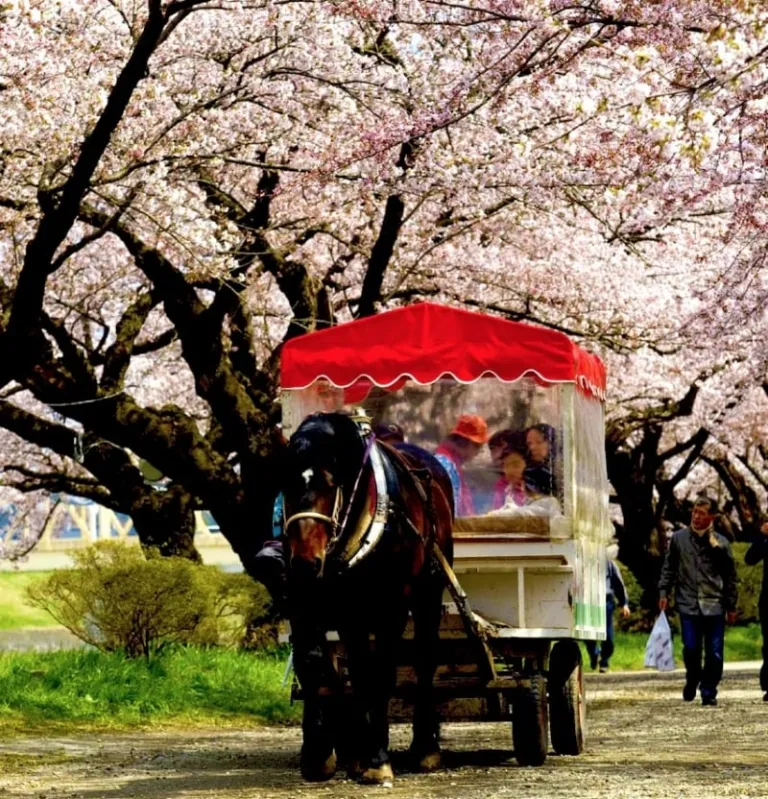
Another of Japan’s Top 100 Sakura Spots, the Kitakami Tenshochi Sakura Festival (held mid April to early May annually) happens over a sprawling 293 square meters and features more than 10,000 trees of over 150 species.
Take a stroll or even a horse wagon ride through 2 kilometres of pink blossoms, stream down the river on a boat ride or visit the nearby Michinoku Folklore Village, which features 30 houses from Tohoku throughout the ages.
Address: Tachibana, Kitakami-shi, Iwate Prefecture
Nearest station: JR Kitakami Station
Getting there: 15-minute walk from JR Kitakami Station. Alternatively, from mid April to early May, a 5-minute boat ride to Kitakami Tenshochi Park is available from JR Kitakami Station.
Admission: Free!
Geibikei
By train: Kitakami Station → transfer at Ichinoseki Station → Geibikei Station
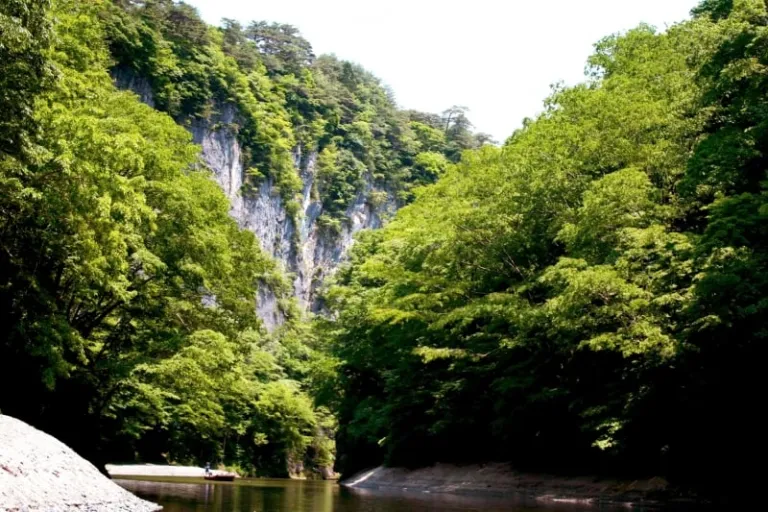
The massive 50m-high rock faces of the Geibikei leave a sense of majesty to those who visit. Join the 90-minute boat ride through the 2-kilometre gorge and immerse yourself spiritually in clear waters and lush nature as the boatman serenades you with his song. After that, test your aim with rock-throwing – good luck is endowed upon you if you succeed in getting it into a special hole in the rock face!
Address: Higashiyama-cho, Ichinoseki 029-0302, Iwate Prefecture
Nearest station: JR Geibikei Station
Getting there: 5-min walk from JR Geibikei Station.
Admission: ¥1,500 for adults, ¥800–1,200 for students
POKÉMON with YOU Train (Geibikei Station → Ichinoseki Station)
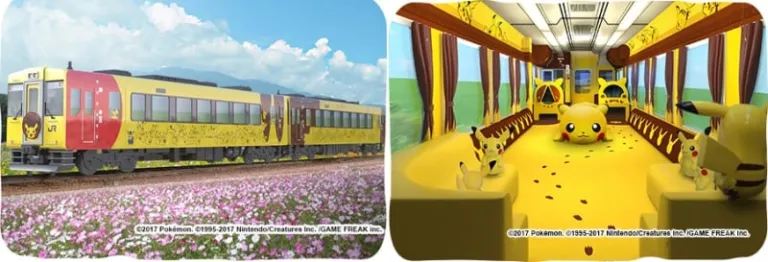
As you head for Ichinoseki from Geibikei, you shouldn’t miss the POKÉMON with YOU Train, an absolutely adorable ride that will fill you with warmth inside.
Devised to cheer children up after the devastating regional earthquake and tsunami in March 2011, the train has had a makeover in 2017 for families to have fun as they head to their destinations. Designed inside-out with depictions of the iconic Pikachu, you’ll be snapping away if you’re a fan of the electric mouse.
Admission: Free with JR East Pass; reservation required
Spend the night in Akita City, or extend your stay!
By train: Ichinoseki Station → Morioka Station (luggage pick-up) → Akita Station
After today’s sights, head back to Morioka to pick up your luggage before moving onward to Akita.
Namahage-kan
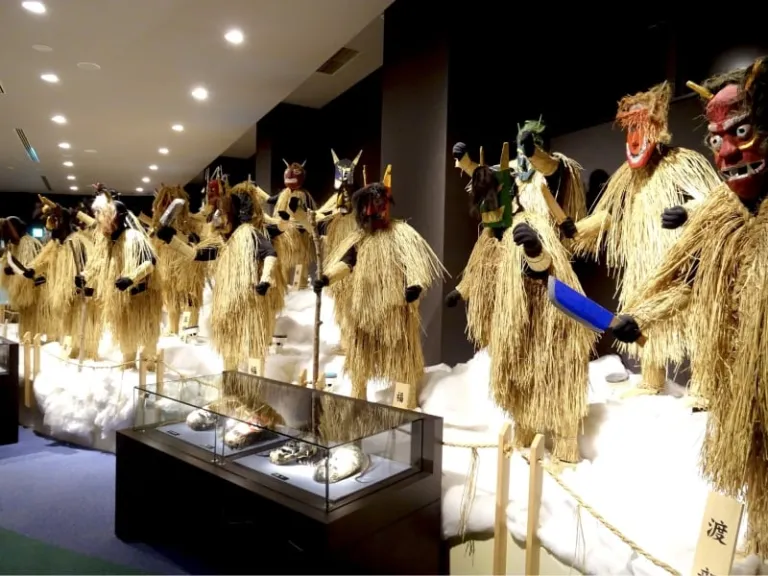
Men don fearsome masks and traditional straw garments on New Year’s Eve in Oga, visiting homes as part of the raiho-shin (ritual visits of deities in masks and costumes). This practice has been added to the UNESCO Intangible Cultural Heritage list, making it a must to visit the Namahage-kan (Museum of Namahage, demon-like beings in Japanese folklore), if you dare.
Address: Mizukuisawa Kitaurashinzan, Oga, Akita Prefecture 010-0685, Japan
Getting there: Board the Namahage Shuttle from the east entrance of Akita Station and get off at the Shinzan Area (reservation required).
Admission: ¥540 for adults, ¥270 for students
Lake Tazawa

Lake Tazawa, Japan’s deepest lake, boasts alluring blue waters and serenity away from noisy crowds. Take in the vastness of the lake at the Goza no Ishi Shrine with its tall torii (a type of Japanese gate, typically the entrance to Shinto shrines) overlooking the waters, and the famous golden Tatsuko statue at the eastern end of the lake holds the tale of a girl with an unrequited wish for eternal beauty.
Address: Tazawakokata, Semboku 014-1203, Akita Prefecture
Getting there: From Akita Station, take the JR Akita Shinkansen or JR Tazawako Line to Tazawako Station. Board the Ugokotsu Tazawako loop bus and get off at Katajiri for the Tatsuko Statue.
Admission: Free!
Nyuto Onsen

If you are a fan of hot springs, you will be spoiled for choice at Nyuto Onsen. Warm up from the last wisps of the winter cold at one of their eight ryokans and hot spring baths, each with different spring sources and water quality.
Address: Tazawako Tazawa, Semboku 014-1204, Akita Prefecture
Getting there: Board the Ugokotsu bus from JR Tazawako Station bound for Nyuto Onsen and alight at the Kyukamura-mae bus stop (stop varies depending on specific onsen)
Admission: ¥520–800 for daytime admissions, depending on specific onsen
Food to try
Dig in to some of Akita’s specialties that will warm you up!

Warm up with a Kiritanpo-nabe that features Akita’s renowned rice – the rice is pounded, then moulded into a tube, followed by grilling before being served in tasty soup. If you love your chicken, Akita’s Hinai Jidori is so good that you can even eat it as sashimi.
The crunchy Iburigakko is a specially smoked pickle that is a must-try for those into tsukemono (Japanese preserved vegetables), while Akita’s sake is made with rice and spring water from the region that is richer and fuller in flavour.
Day 4 of Pass Usage: Akita → Kakunodate & Hinokinai River → Resort Shirakami Train → Hirosaki Castle Park
Kakunodate Samurai Residences & Hinokinai River
By train: Akita Station → Kakunodate Station
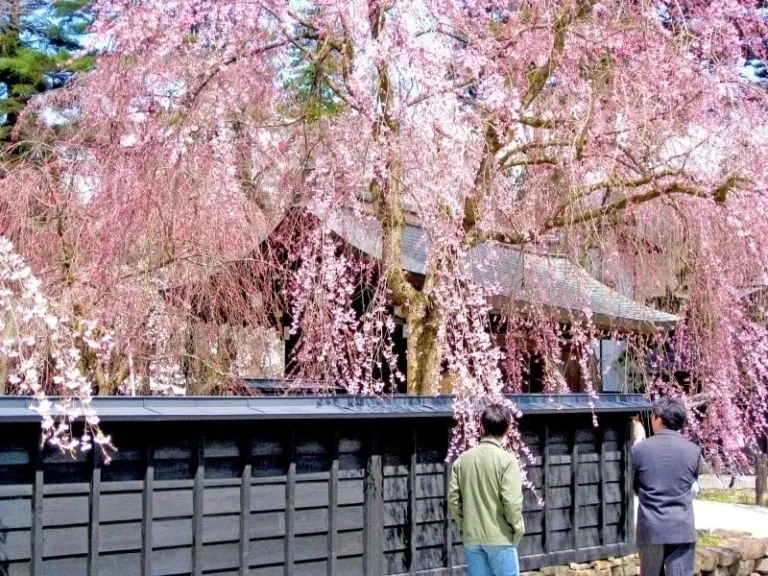
Step back in time to when samurais roamed the streets beneath the shidare-zakura (weeping cherry blossoms) branches drooping over the Kakunodate Samurai Residences.
Visit Akita’s biggest Annual Cherry Blossom Festival in the castle town and enjoy delicious food and lively performances, followed by a short walk to take in the beauty of the 400 cherry trees that line the Hinokinai River.
Address: Higashikatsurakucho, Kakunodate Machi, Senboku-shi, Akita Prefecture
Nearest station: JR Kakunodate Station
Getting there: 15-min walk from JR Kakunodate Station
Admission: Free!
Resort Shirakami Train (Akita Station → Hirosaki Station)

After taking in the sights of Kakunodate, head back to Akita Station to board the Resort Shirakami Joyful Train. Take in the beautiful coastline of Tohoku on board, as you head towards Hirosaki.
With soft yet vibrant interiors and wide windows, be uplifted as you take in clear skies and vast views of the Pacific Ocean, of which you can alight and take pictures along the way during rest stops. Traditional music and art performances on board make the trip all the more engaging.
Admission: Free with JR East Pass; reservation required
Hirosaki Castle Park
By train: Akita Station → Hirosaki Station
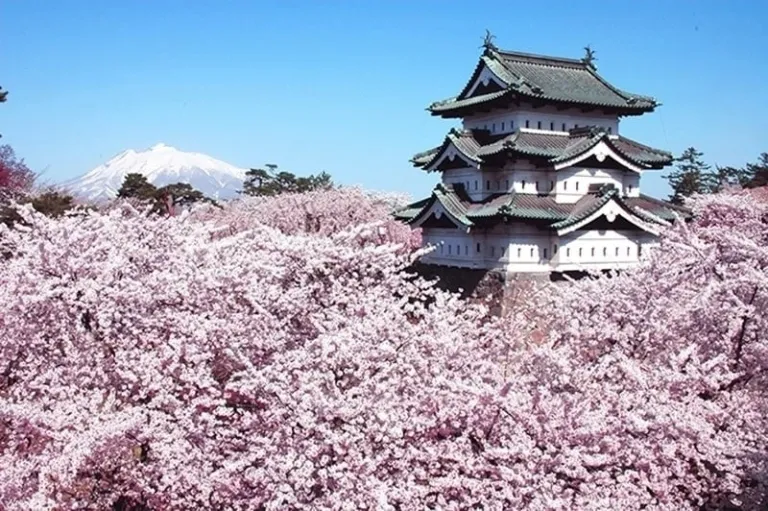
2,600 cherry blossom trees dot the grounds of Hirosaki Castle Park, making it another of Japan’s Top 100 Sakura Viewing Spots. Row down the castle moat, have fun at the festival (held from late April to early May annually), or just marvel at the petals-covered ground and waters.
Address: 1 Shimoshirogane-cho, Hirosaki-shi, Aomori Prefecture
Nearest station: JR Hirosaki Station
Getting there: 15-minute bus ride from JR Hirosaki Station
Admission: Free!
Spend the night in Hirosaki or Aomori, or extend your stay!
By train: Hirosaki Station → Aomori Station
Whether you catch a night’s rest in Hirosaki or Aomori, you’d not want to miss the chance to explore Aomori.
Oirase Keiryu

Flowing water cascades down Oirase Keiryu, a mountain stream amidst lush flora, where the Choshi Otaki Waterfall may be found.
Trek along the stream on your own, or head to the Yakeyama Resort for stream viewing tours. The stream’s endpoint, Lake Towada, is in itself a beautiful lake where you can board cruises that sail through its blue waters.
Address: 183 Tochikubo, Okuse, Towada-shi, Aomori-ken
Getting there: From JR Aomori Station or JR Shin-Aomori Station, take the JR Tohoku Bus, Mizuumi – free rides are available with the JR East Pass.
Admission: Free!
Food to try

The ideal location of Mutsu Bay allows for one to enjoy a wide variety of seafood fresh off the boat. Enjoy some prized Oma Tuna (fatty Pacific bluefin tuna), scallops and various other kaisen (seafood) sold in restaurants and markets in various cities such as Aomori and Oma.
Day 5 of Pass Usage: Hirosaki → Nebuta Wasse → Furukawa Seafood Market (Nokke Don) → Tokyo
Hirosaki Castle Park
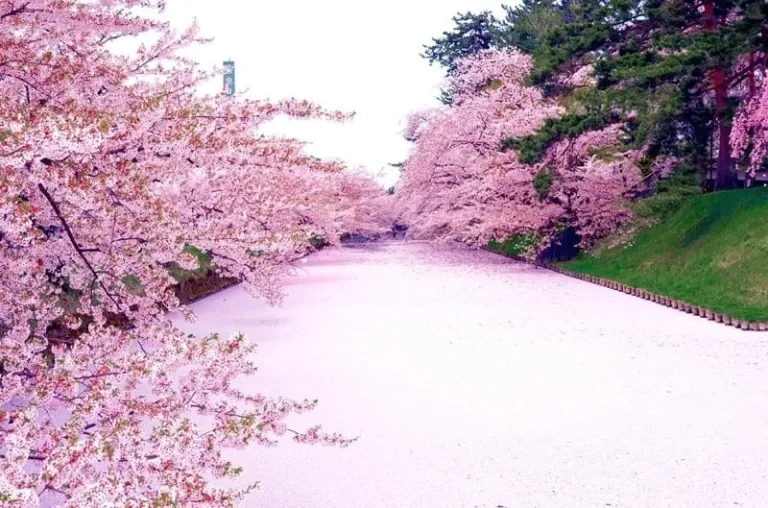
If yesterday’s crowds were too much for you, return to Hirosaki Castle Park in the morning for a quieter experience.
Head over to the Tsugaru-han Neputa Village for a glimpse of Hirosaki’s famous Neputa Festival, try your hand at traditional tsugaru crafts or the rousing tunes of tsugaru shamisen (a genre of Japanese music). Nearby Fujita Memorial Garden also offers a serene experience across Japanese landscapes, as well as interesting buildings like its traditional tea ceremony houses and quaint Western House.
Nebuta Warasse

Relive the summer festivities of the Nebuta Matsuri even in spring at the special Nebuta Warasse, which houses four colourful, larger-than-life festival floats. Take part in the festival experience held three times a day and learn about its history and Noh papering, the process used to make the floats.
Address: 1 Chome-1-1 Yasukata, Aomori, Aomori Prefecture 030-0803, Japan
Getting there: Take a short walk from Aomori Station
Admission: ¥600 for adults, ¥250–450 for students
Furukawa Seafood Market (Nokke Don)

Enjoy picking your favourite seafood for your nokke don (DIY seafood rice bowl) at Furukawa Fish Market, where a coupon system allows you to customise the ingredients of your bowl from the various stalls around. Dig into your food fresh on site with a free cup of tea or water at the dedicated sitting area.
Address: 1-11-16 Furukawa, Aomori City, Aomori
Getting there: Nebuta Warasse is just a short walk from Aomori Station.
Admission: Free!
Hop on the Shinkansen back to Tokyo and conclude your Tohoku adventure!
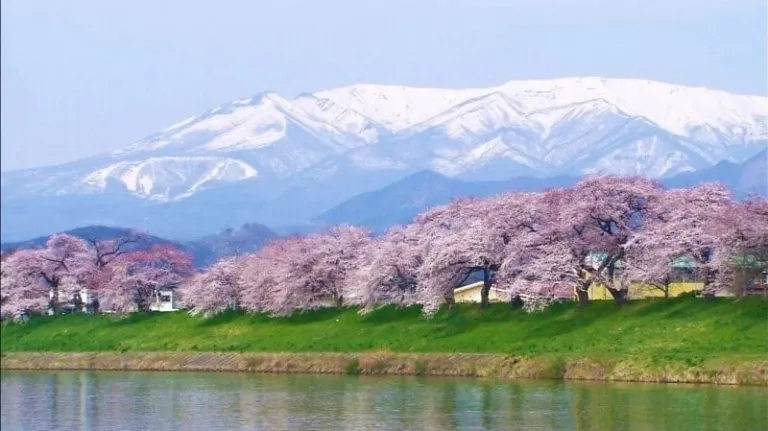
The region of Tohoku is a place where the locals have lived in both nature and long-standing tradition. On top of spectacular sakura blooms and unique natural beauty, it also offers a glimpse into how the people in the region have adapted to the harsh climate and developed a lifestyle around it.
With the JR East Pass, you can not only reach these places with ease through the various shinkansen and trains available, but also substantial savings in transport costs – up to a whopping ¥58,140 for this trip!
| Pass Usage | Train Trips | Point to point cost |
| Day 1 | Tokyo – Fukushima | ¥8,950 JPY |
| Fukushima – Koriyama – Miharu | ¥3,300 JPY | |
| Miharu – Koriyama – Sendai | ¥5,380 JPY | |
| Day 2 | Sendai – Fukushima | ¥3,680 JPY |
| Toreiyu Tsubasa (Fukushima – Yamagata) | ¥3,190 JPY | |
| Yamagata – Sendai – Funaoka | ¥1,660 JPY | |
| Funaoka – Sendai – Morioka | ¥6,780 JPY | |
| Day 3 | Morioka – Kitakami | ¥3,200 JPY |
| Kitakami – Ichinoseki – Geibikei | ¥3,500 JPY | |
| POKÉMON with YOU Train (Geibikei – Ichinoseki) | ¥1,020 JPY | |
| Ichinoseki – Morioka – Akita | ¥8,010 JPY | |
| Day 4 | Akita – Kakunodate | ¥3,020 JPY |
| Kakunodate – Akita | ¥3,020 JPY | |
| Resort Shirakami (Akita – Hirosaki) | ¥4,950 JPY | |
| Day 5 | Hirosaki – Aomori – Tokyo | ¥17,480 JPY |
| Total: | ¥77,140 JPY | |
| Cost of JR East Pass: | ¥19,000 JPY | |
| Savings from using JR East Pass: | ¥58,140 (~₱27,900) | |
(Approximate cost of point-to-point tickets including reserved seat fees, from www.hyperdia.com)
Besides gaining special experiences aboard JR East’s Joyful Trains, you also get to enjoy flexibility in your travel plans, as you can extend your stay in cities you love without having to worry about missing your train rides.
It’s a great way to travel around the picturesque region of Tohoku!
| Did you know that there are region-specific rail passes that are more cost-effective than a standard JR Pass?
The JR East Pass (Tohoku Area) offers UNLIMITED RIDES on all JR East Rail Lines in the designated area, and is also valid for the Narita Express to/from Narita Airport, Tokyo Monorail to/from Haneda Airport and all Shinkansen lines. You also get free rides on the uniquely-themed Joyful Trains with a JR East Pass! Learn more about the Joyful Trains here. Make advance reservations up to one month before departure – you’ll need it, especially during peak seasons! The pass is valid for use for any five days within a 14-day period after collection, and you can purchase them in Japan or through licensed sales agents overseas. Psst! The pass is ¥1,000 cheaper if you purchase it from travel agents! Contact any of the travel agencies below to purchase your JR East Pass (Tohoku Area) and immerse yourself in nature’s finest beauty this sakura season! |
JTB
Tel: +63 (02) 894 5528
Website (Philippines)
H.I.S.
Tel: +63 (02) 822 4496
Website (Philippines)
Brought to you by JR East (East Japan Railway Company).
Published at
About Author
Gabriel Oh
Subscribe our Newsletter
Get our weekly tips and travel news!
Recommended Articles
My 10-Day Southern Vietnam Backpacking Trip for Less Than ₱15k 10 Family Outing Ideas in Metro Manila Under ₱500 Looking for a weekend bonding with the family under ₱500? Head to these places, pronto!
10 Fun Things to Do in Manila Alone Live your best life in Manila, even when you’re riding solo.
10 Long Weekends in the Philippines in 2023 Book those flights ASAP.
10 Things to Do in Clark for Your Next Weekend Getaway The ideal weekend destination for every traveller.
Latest Articles
Luisa Yu: 80-Year-Old Filipina Travelled 193 Countries in the World Travel has no limits, and neither does Luisa Yu at 80!
Cebu Pacific’s First Clark to Coron Flight Takes Off! Direct flights to Coron now boarding!
7 Best Pet-Friendly Beach Resorts in Batangas and Zambales Why leave your pet behind when these pet-friendly beach resorts in Batangas and Zambales offer the perfect getaway?
Calbayog Zipline: One of the Longest Overwater Rides in the Philippines Glide over the ocean on one of the longest overwater ziplines in the Philippines
Complete Thrilling Travel Guide to Cambugahay Falls in Siquijor Swing, swim, and soak in the beauty of Cambugahay Falls Siquijor!



